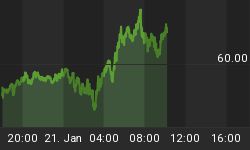What a disappointment! We had high hopes for the Icelandic volcano. Not since preparations for the Millennium Bug has our mood been so upbeat. A real shot at a good calamity seemed to be possible. Then, it dwindled to nothing more than hot flatulence rather than the real thing. But, the Icelandic volcano is still there, trying to make things right. Well, it is only day 13 of the volcano, and you know what they said about the little train.
Much of what has been written on the volcano misses the point. Some travelers stranded for a few days do not sum to a meaningful economic event. Neither is the threat of mountains of ash reigning down on Europe the concern. Whatever the size of the volcano, the accumulation of particles in the air is potentially the story. Numerous climatologists have now been quoted as saying that the volcano will not change the climate. SUVs and cow flatulence will, but volcanos will not. No, the real story is whether or not the weather for this coming crop season has been altered from that which would have existed without the volcano ash interfering with the light of the Sun reaching plants.

Whatever the accumulation of ash in the skies might be, the level of sun reaching the plants in the affected area will be less than would have been the case without the volcano. Part of the story also is fragile nature of the supply and demand balance in global Agri-Foods. Our first chart above is of the global wheat savings rate. Whatever part of production, or income, not consumed is by definition what is saved. If the value plotted in the above chart is negative, the world is consuming more wheat than it is producing.
The world got lucky in 2009, and may again in do so in 2010. Rose-colored forecast from the USDA puts the global wheat savings rate for the coming year at only slightly more than 4%. That forecast suggests little, or no, room for error. Any negative production event in world wheat, be it from volcano ash accumulation in the atmosphere or just bad luck, could force the world to turn to that which is in storage.
Some forecasters would have us believe the size of the world's wheat reserve is immense. Further, that reserves of such size guarantee no shortages. But, are the world's reserves really that large? In absolute terms the size is large, but one must also consider the denominator.
| MEASURE | MONTHS OF CONSUMPTION |
| WORLD, UNADJUSTED | 3.6 |
| CHINA | 7.0 |
| WORLD, WITHOUT CHINA | 3.0 |
As the above table indicates, when the denominator is properly considered, the world is not awash in wheat. If the large reserves of China are excluded, the world has only 3 months of wheat consumption in reserve. With only 3 months of wheat consumption in storage, any shock, however small and deemed insignificant, could unmask the inadequacies of the global Agri-Food system. At this time price is the only consideration. At some future time, availability could become more important than price.

Our second chart, above, portrays what can happen with Agri-Food prices in a very short period of time. That graph is of the USDA index of prices for hanging and boxed beef. Since the bottom in November, beef prices have risen about 25%. Annualized, that is an impressive rate of increase. The base in that graph is about 9-10 months. Given the size of that base and time required to rebuild herds, the top in beef prices will not come with a 2010 handle. Please note that calves are not produced in factories.
How can prices move such as pictured in the above graph? Globally, the Agri-Food industry is operating in the price inelastic component of the long run Agri-Food supply curve. That means that percentage price moves are far greater than percentage change in demand. Or, a small change in demand results in a far greater move in prices. Little demand can push prices up dramatically. Few, if anybody, predicted a year ago the volcano eruption. Even fewer have the ability to determine its impact on wheat prices a year from now given the existing price inelasticity of Agri-Food.
Agri-Food prices have the potential, given the price inelasticity, to rise dramatically in the years ahead. The basic driver of all Agri-Food investments is the price at which Agri-Food commodities are sold. Given the continued fixation of the investment world on technology and financial stocks, opportunities may exist for investors in Agri-Food investments. To gain an understanding view our quarterly report on the topic, Agri-Food Commodities: An Investment Alternative. You may read that report at this link: http://www.agrifoodvalueview.com/files/Agri-Food_Commodites_An_Investment_Alternative_2010_April.pdf
AGRI-FOOD THOUGHTS is from Ned W. Schmidt,CFA,CEBS, publisher of The Agri-Food Value View, a monthly exploration of the Agri-Food grand cycle being created by China, India, and Eco-energy. To contract Ned or to learn more, use this link: www.agrifoodvalueview.com
















